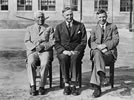Colonial apprentices
New Zealand’s colonists brought with them the traditional British apprenticeship system. Apprentices, who were usually young men or boys, completed a specified period of training, often lasting several years, by working and learning on the job alongside a skilled tradesperson (known as a journeyman). This system was vital for supplying the skilled labour required to build and service the rapidly growing colony.
At first there were very few laws controlling how apprentices could be engaged and how they learned their trades. Under the Master and Apprentice Act 1865 an employer was simply expected to provide ‘sufficient and suitable’ food, clothing and bedding, and to ensure that the apprentice attend church and pay attention to his morals. This lack of formal control led to concerns that some businesses were apprenticing children as young as 12, using them as unskilled labour and sometimes paying them nothing while they learned their trade. They could then be fired as soon as they completed the term of their apprenticeship, so their employer avoided paying them the wage of a skilled worker.
The social laboratory
In the 1890s New Zealand passed advanced industrial relations legislation, which earned it the title of the world’s ‘social laboratory’. This included reforms of the apprenticeship system. Because there were still few laws specifically controlling apprenticeships, apprentices’ conditions were negotiated as part of the awards (legally enforced minimum wages and conditions) of individual industries, such as printing or tailoring. Apprenticeship conditions became a significant bargaining element in award negotiations between unions and employers. The unions argued strongly for adequate training of apprentices, and for a maximum ratio of apprentices to skilled workers, such as one to three, in order to protect jobs.
Apprenticeship Act 1923
The introduction of electricity and motor cars in the early 20th century meant some trades such as saddle-making practically disappeared, while new ones emerged, such as electrical engineering. Most other trades changed dramatically, as new equipment was introduced and manufacturing processes moved from craft-based small industry towards mass production. To meet these changes apprentices needed increased training to nationally agreed standards.
Apprentice sweeper
Employers often preferred to restrict apprentices to routine work since this was cheaper than teaching them advanced trade skills. When the Apprenticeship Act 1923 required employers to let apprentices study during working hours, one employer objected strongly: ‘What is the duty of a boy when he goes into the shop? The first thing … that the boy has to do is to learn how to sweep out that shop … order and discipline are to the benefit of a boy.’1
The Apprenticeship Act 1923 set up voluntary local apprenticeship committees for each industry and controlled the wages, hours and conditions of apprentices, and the period of their apprenticeship (typically three to five years). At first the act applied only to male apprentices, but women were covered from 1926, when the first female hairdressing apprenticeships were recognised. The act also required apprentices to gain part of their training at technical schools, which later became polytechnics. Firms that employed a number of apprentices, such as those in the motor vehicle industry, contributed towards the cost of these technical schools.
Training in wartime
The outbreak of the Second World War forced New Zealand’s small manufacturing industry to adapt rapidly to making high-quality military equipment, and tested the ability of apprentices to learn new skills on unfamiliar machinery. More than 500 ships were built during the war, including some for US forces. One US officer said, ‘[T]he quality of the work performed by apprentice-trained artisans for the US Marine Corps in New Zealand has been … unequalled elsewhere in the world.’2
During wartime women entered the manufacturing workforce in large numbers, but employers and the government assumed that they would leave those jobs at the end of the war. Because of this, they were mostly restricted to simple tasks and gained very little trade training.
